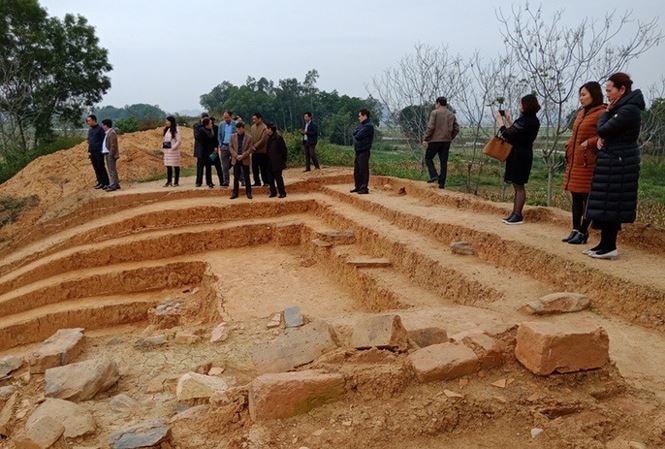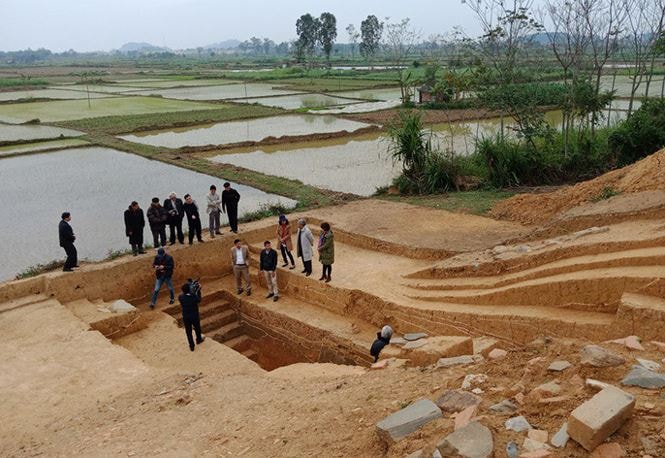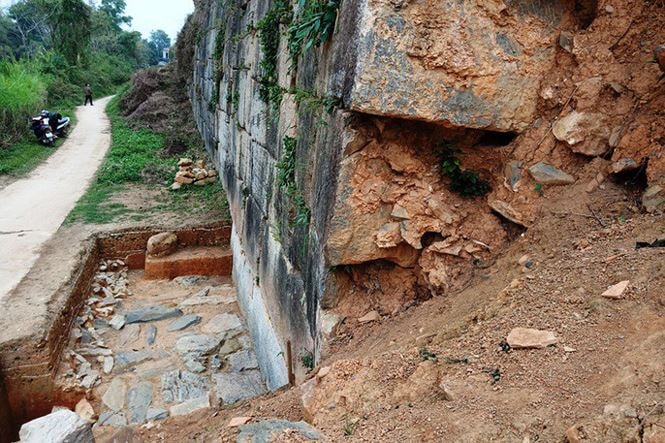Revealing the construction techniques of the Ho Dynasty Citadel that has existed for over 600 years
Through exploration and excavation of the walls and citadel body at the world cultural heritage site of the Ho Dynasty Citadel (Thanh Hoa), scientists have partly decoded the secret of building the massive stone citadel that has existed for more than 600 years of the Ho Dynasty.
 |
A section of the Ho Dynasty Citadel was cut to excavate to learn about the construction techniques that have existed for more than 600 years. |
On January 22, the Vietnam Institute of Archaeology and the Ho Dynasty Citadel Heritage Conservation Center (Department of Culture, Sports and Tourism of Thanh Hoa province) officially announced the results of the excavation of a section of the northeastern citadel wall of the world cultural heritage Ho Dynasty Citadel, in Vinh Loc district, Thanh Hoa province.
According to Dr. Do Quang Trong, Director of the Ho Dynasty Citadel Heritage Conservation Center, implementing the decision of the Ministry of Culture, Sports and Tourism, the unit has coordinated with the Vietnam Institute of Archaeology to conduct excavations on the Northeast wall of the Ho Dynasty Citadel with a total area of about 400 m2 with the aim of better understanding the techniques of reinforcing the earth layer on the wall, the reinforced foundation layer and the need to reinforce the foot of the Northeast wall area.
"The excavation results have provided many important data, helping to clarify the construction techniques of the Ho Dynasty Citadel, thereby greatly helping the restoration of this deteriorating world heritage," said Mr. Trong.
 |
The excavation area is located right at the landslide site in the Northeast - Ho Dynasty Citadel. |
According to the preliminary report, after 5 months of excavation (from September 2018 to January 2019), archaeologists concluded that the wall had a structure built with soil on the body and inside, and the outside of the wall was covered with stones of different sizes, some weighing tens of tons. Notably, the excavation process discovered that the wall was built with 11 layers of soil and gravel, very meticulously, solidly and firmly.
From top to bottom, the upper surface layer of the wall is 8.5-9 m wide, made of gravel, stone, and clay that is compacted and compacted to help the wall not be destroyed by the sun and rain; the second layer is red, yellow, and green clay mixed with sand, 0.5-0.55 m thick, compacted and compacted along the slope down towards the wall; the third layer is light yellow clay mixed with many sand grains, about 1 m thick; the fourth layer is red clay mixed with many gray clay clumps, 0.5-0.6 m thick; the fifth layer is light yellow clay mixed with many small sand grains and laterite gravel, about 0.8 m thick.
Next is the 6th layer of dark gray clay with a thickness of 0.18-0.2 m; the 7th layer is yellow clay mixed with compacted yellow sand, with a thickness of 0.06-0.08 m; the 8th layer is a layer of dark gray soil compacted from the surface of the wall down to the foot of the wall, with a thickness of 0.18-0.2 m; the 9th layer is yellow clay mixed with a little sand, with a thickness of 0.08-0.1 m; the 10th layer is compacted dark gray soil running from the surface of the wall down to the foot of the wall, with a thickness of 0.5-0.6 m; the last layer close to the foot of the wall is a layer of dark red clay compacted tightly, firmly and clearly separated from the upper and lower layers, with an average thickness of 1.7-1.8 m.
 |
Through this excavation result, many data about the construction techniques of Ho Dynasty Citadel are gradually revealed. |
Regarding the foundation of the citadel wall, scientists discovered that the foundation was also reinforced with a fairly even layer of blue-gray clay. Next was a layer of gravel, crushed stone (1.2x5 cm in size) and a layer of yellow clay. In total, the foundation alone had 7 layers reinforced with gravel and a layer reinforced with red clay (1.7-1.8 m thick). From the results of research on the structure of the wall and the base of the wall, archaeologists concluded that the wall and the base of the wall of the Ho Dynasty Citadel heritage were made of gravel, yellow, red, blue-gray clay and coarse sand. Regarding the soil for building the citadel, researchers initially determined that the soil was taken from the process of expanding the outer layer of the moat.
In addition, during the excavation process, many relics were discovered, such as bricks, tiles, white-glazed, blue-and-white, brown-glazed, jade-glazed ceramic bowls, and bricks dating from the Tran - Ho and Le dynasties.
With the excavation results, scientists have determined that the scale of the structure of this world heritage wall is extremely complex and solid, which partly helps to clarify how the wall was built in ancient times. From there, it creates a scientific basis for the restoration of the northern wall area and clarifies the reinforced structure of the earth wall inside the stone wall.
Ho Dynasty Citadel (also known as Tay Do Citadel) in Vinh Long and Vinh Tien communes, Vinh Loc district, Thanh Hoa province, is one of the most unique stone architectural works in Vietnam and the world. The work was built by Ho Quy Ly in 1397, and was once considered the capital, the cultural, political and social center of Dai Ngu country under the Ho Dynasty.
After more than 600 years of existence with many historical events, most of the imperial citadel was destroyed, but the citadel remained almost intact... On June 27, 2011, the Ho Dynasty Citadel was officially recognized as a world cultural heritage by the United Nations Educational, Scientific and Cultural Organization (UNESCO).


